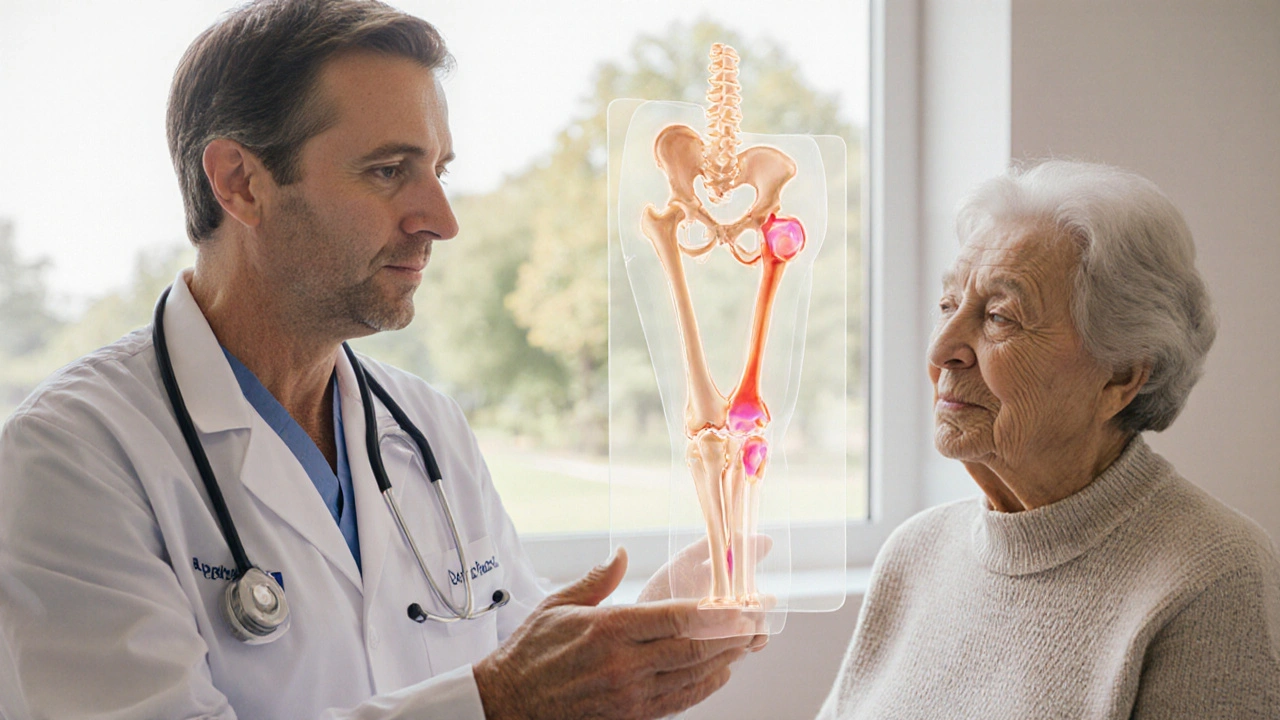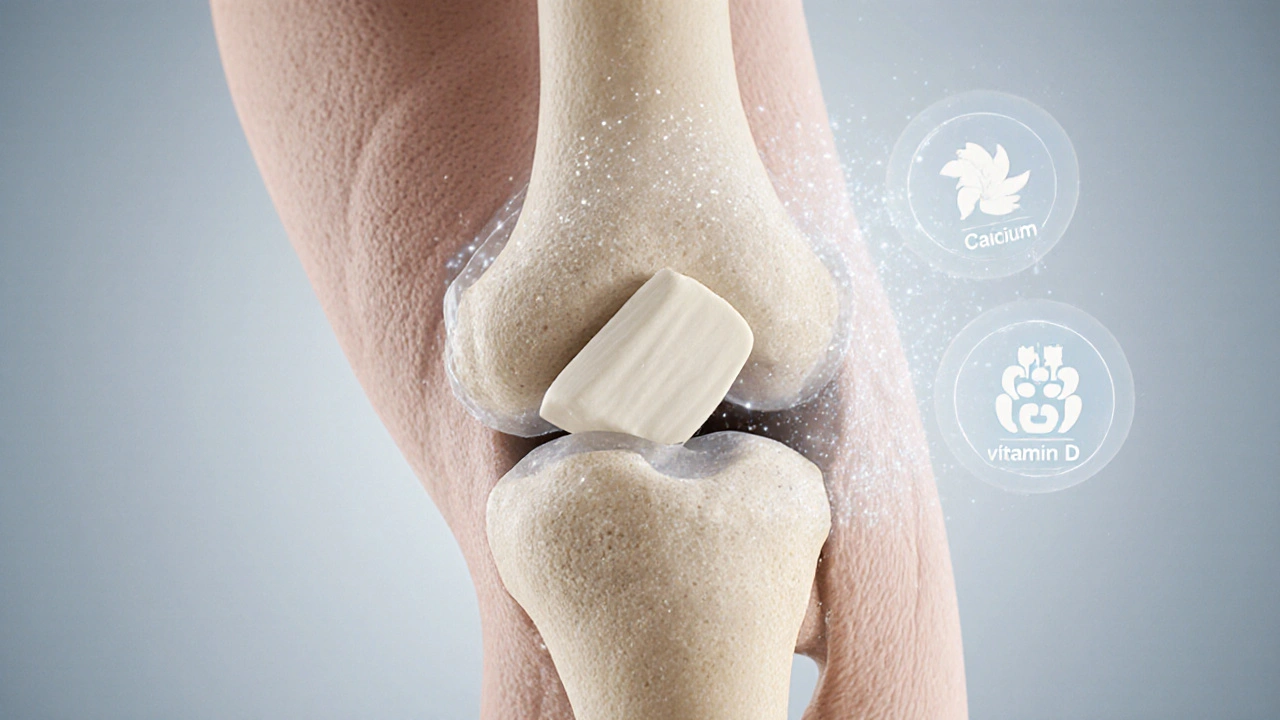
Bone Graft Success Rate Estimator
This tool estimates the likelihood of successful bone graft integration based on osteoporosis severity and graft type.
TL;DR
- Osteoporosis weakens bone, making grafts harder to heal.
- bone graft can come from you, a donor, or a lab‑made material.
- Autografts have the highest success but need a second surgical site.
- Allografts avoid extra cuts but carry a tiny disease‑transmission risk.
- Good nutrition (calcium, vitaminD) and proper meds boost graft outcomes.
Understanding Osteoporosis
When doctors talk about Osteoporosis is a chronic condition where bone density drops and the skeleton becomes fragile, they’re warning about a silent erosion that can happen to anyone over 50, especially post‑menopausal women. In the UK, roughly one in three women and one in five men will break a bone because of osteoporosis before age 80. The disease doesn’t just increase fracture risk; it also slows the body’s natural ability to remodel bone after injury.
Why does this matter for grafts? Bone healing relies on a balance of cells that break down old bone (osteoclasts) and cells that build new bone (osteoblasts). Osteoporosis tips the scale toward resorption, meaning any graft placed into a weak site faces an uphill battle to integrate.
What Is a Bone Graft?
When surgeons need to fill a gap-whether after a tumor removal, a spinal fusion, or a dental implant-they turn to bone graft is the process of transplanting bone tissue or a bone‑substituting material to support new bone growth. The goal is simple: provide a scaffold that encourages the body’s own cells to lay down fresh, strong bone.
How Osteoporosis Impacts Graft Success
In an osteoporotic spine, the surrounding vertebrae may be too porous to hold a graft firmly. This can lead to:
- Reduced mechanical stability, increasing the chance of hardware failure.
- Slower incorporation of the graft because osteoblast activity is already low.
- Higher risk of adjacent‑level fractures as the spine redistributes load.
Because of these challenges, surgeons often adjust their approach-choosing graft types that release growth factors, adding bone‑strengthening medications, and rigorously monitoring bone density before and after surgery.

Types of Bone Grafts
Not all grafts are created equal. Below is a quick snapshot of the three main families used in osteoporotic patients.
| Graft Type | Source | Risk of Disease Transmission | Typical Cost (UK) | Success Rate in Osteoporotic Bone |
|---|---|---|---|---|
| Autograft | Patient’s own bone (usually iliac crest) | None | £1,500‑£2,500 | ≈85‑90% |
| Allograft | Donor bone from tissue bank | ~0.01% (viral, bacterial) | £800‑£1,200 | ≈70‑80% |
| Synthetic bone graft | Lab‑made calcium phosphate or hydroxyapatite | None | £500‑£1,000 | ≈65‑75% |
Autografts win on biology-they contain living cells and growth factors that jump‑start healing. The trade‑off is an extra incision and longer operative time. Allografts and synthetics avoid donor‑site pain but may need adjuncts like BMP (bone morphogenetic protein) or stronger fixation to reach similar success rates.
Choosing the Right Graft for Osteoporotic Patients
When a surgeon evaluates you, they weigh several factors:
- Severity of bone loss (DXA T‑score).
- Location of the defect (spine, hip, jaw).
- Overall health and ability to tolerate a second wound.
- Availability of donor bone and budget considerations.
For severe osteoporosis (T‑score ≤‑2.5), many clinicians favor an autograft combined with a small amount of synthetic filler to boost mechanical strength. In dental cases, a mix of synthetic bone graft and platelet‑rich plasma can give a predictable outcome without a second surgical site.
Preparing for Surgery: Nutrition and Medication
Even the best graft can fail if the body’s building blocks are missing. Here are the three pillars that support bone healing:
- Calcium is the primary mineral that forms the hard matrix of bone. Aim for 1,200mg daily via dairy, leafy greens, or fortified foods.
- VitaminD is essential for calcium absorption and osteoblast function. Sun exposure plus 800‑1,000IU supplements is a safe target for most Britons.
- Bisphosphonates are drugs that slow bone resorption and are often prescribed for osteoporosis. They should be paused at least two weeks before major graft surgery to avoid impairing new bone formation.
Talk to your GP or endocrinologist about timing. In some cases, a short course of anabolic agents like teriparatide (PTH 1‑34) can actually accelerate graft integration.
Post‑Operative Care and Success Tips
After the graft, the real work begins:
- Weight‑bearing instructions: Follow the surgeon’s timeline-most spine grafts require 6‑12weeks of limited load.
- Physical therapy: Targeted core and limb exercises improve circulation, which feeds the graft.
- Bone‑density monitoring: A repeat DXA scan at 6months helps gauge whether your bone health is improving.
- Medication adherence: If you’re on a calcium‑vitaminD combo or a bisphosphonate holiday, stick to the schedule.
- Watch for red flags: Sudden pain, swelling, or loss of mobility could signal graft failure or infection.
Most patients report noticeable improvement in pain scores within three months, but full graft remodeling can take a year or more.
Common Myths Around Osteoporosis and Grafts
Myth1: “If I have osteoporosis, I can’t have a bone graft.” Not true-grafts are often used precisely because bone has weakened.
Myth2: “Allografts are unsafe.” Modern tissue banks use rigorous sterilization; the risk is minuscule compared to the benefit.
Myth3: “Supplements alone will fix a bone defect.” Supplements support healing but can’t replace the structural scaffold a graft provides.

Frequently Asked Questions
Can osteoporosis cause a bone graft to fail?
Yes, because the underlying bone is less dense and remodels slower. However, choosing the right graft type, optimizing nutrition, and managing medication can bring success rates up to 85%.
Is an autograft always the best option?
Autografts have the highest biological activity, but they require a second surgical site. For patients who can’t tolerate extra incisions, allografts or synthetics are viable alternatives.
How long before I can return to normal activities?
It depends on the graft location. Spinal fusions typically need 6‑12weeks of limited load; dental implants may allow light chewing in 2‑3weeks. Follow your surgeon’s specific plan.
Should I stop bisphosphonates before surgery?
Most experts recommend a brief holiday-about two weeks-before major graft surgery to avoid suppressing new bone formation. Always discuss timing with your doctor.
Are synthetic grafts safe for the spine?
Yes. Modern calcium‑phosphate ceramics are biocompatible and can be engineered to match the spine’s load‑bearing needs. They’re often combined with growth‑factor carriers for better integration.

Willy garcia
September 29, 2025 AT 23:34If you're dealing with osteoporosis and considering a graft start by getting a clear DXA reading first that score will guide whether an autograft allograft or synthetic option makes sense for you remember to discuss with your orthopedic surgeon the specific risks related to bone density keeping calcium and vitamin D intake steady will also boost integration success
zaza oglu
October 6, 2025 AT 21:56Wow-what a vibrant toolbox you’ve laid out! 🌟 The way you break down graft types feels like a culinary menu for surgeons-pick your protein, your spice, and voilà, bone healing! Autograft is the home‑cooked classic, allograft the generous pot‑luck, and synthetic the futuristic lab concoction! 🌈 Keep those success percentages shining; they’re the fireworks that light up the operating room!!!
Vaibhav Sai
October 13, 2025 AT 20:17Understanding how osteoporosis impacts bone graft integration is crucial for both patients and clinicians. The severity of bone loss, reflected by the DXA T‑score, directly influences the biological environment where the graft will sit. A mild T‑score indicates relatively preserved trabecular architecture, allowing most graft types to incorporate with high reliability. Moderate osteoporosis reduces vascular ingress and cellular recruitment, which can lower the success of allografts that depend on host remodeling. Severe osteoporosis presents the toughest challenge, often necessitating autografts that provide living osteogenic cells to jump‑start healing. Autografts, harvested from the patient’s own pelvis or rib, carry osteoconductive, osteoinductive, and osteogenic properties all in one package. Allografts, sourced from screened donors, supply a scaffold but lack live cells, making them more sensitive to the host’s bone quality. Synthetic grafts such as calcium phosphate or hydroxyapatite offer a biocompatible framework that can be engineered to release growth factors, yet they rely entirely on the patient’s biology for new bone formation. Recent studies suggest that combining synthetic scaffolds with platelet‑rich plasma can partially offset the deficits seen in severe osteoporosis. Pre‑operative optimization-adequate vitamin D, calcium, and possibly anti‑resorptive therapy-has been shown to improve graft incorporation across all categories. Surgeons also adjust fixation techniques, using locking plates or screws to provide mechanical stability while the graft consolidates. Post‑operative rehabilitation should be graded, protecting the graft site from excessive load while encouraging gentle weight‑bearing to stimulate remodeling. Monitoring with serial imaging helps detect early signs of graft failure, allowing timely intervention. Patient education remains a cornerstone; individuals who understand the timeline and risks are more likely to adhere to medication and activity guidelines. In summary, the interplay between osteoporosis severity and graft choice is a nuanced decision matrix that benefits from a personalized, data‑driven approach.
kevin tarp
October 20, 2025 AT 18:38The data you presented aligns with current literature; mild T‑scores indeed yield >90 % integration for autografts, while severe scores drop synthetic success to around 70 %.
SandraAnn Clark
October 27, 2025 AT 17:00Sounds like a lot of numbers but at the end of the day you still need a healthy diet and a good doctor.
Rex Wang
November 3, 2025 AT 15:21It’s tough dealing with bone loss, but knowing these stats can help set realistic expectations for recovery.
mark Lapardin
November 10, 2025 AT 13:42From a biomechanical perspective, the modulus mismatch between host osteoporotic cancellous bone and high‑density allograft can induce stress shielding, thereby compromising load transfer and osteointegration, especially in the context of compromised trabecular microarchitecture.
Barry Singleton
November 17, 2025 AT 12:04While the percentages look impressive on paper, real‑world outcomes often fall short because patient compliance and comorbidities are rarely accounted for in these idealized models.
Javier Garcia
November 24, 2025 AT 10:25Great summary.
Kasey Lauren
December 1, 2025 AT 08:46That brief line captures the essence-stay positive and keep moving forward with the right support!
joshua Dangerfield
December 5, 2025 AT 23:34Totally agree with you, it’s definetly better when everyone feels they have a clear path forward-its not just about the numbers, it’s about feeling incluuded in the whole process.